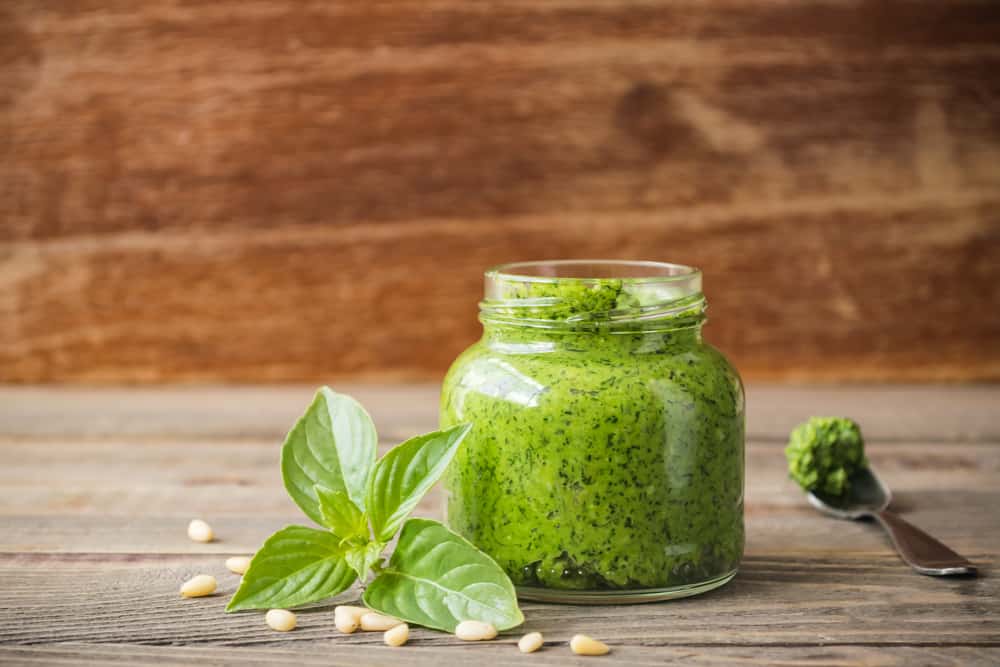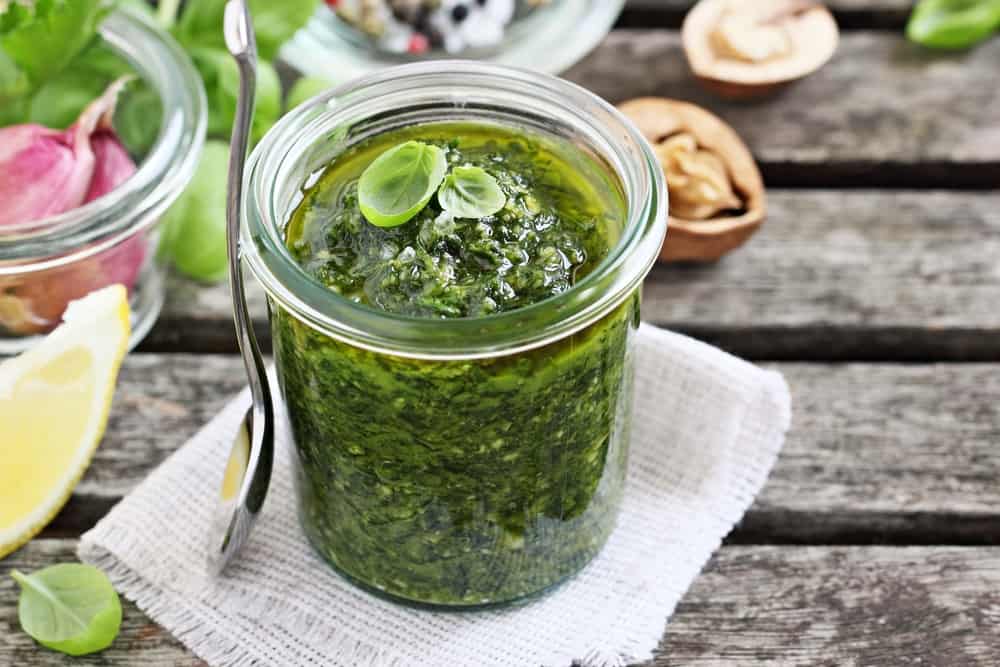So you’re planning on making some pesto at home or buying a few cans from the grocery store but are a little skeptical because you’re not sure how long they’ll last?
Stay tuned, as this post has the answer you are looking for. We talk about pesto shelf life, storage, and how to tell if the sauce has gone bad to help you get the most out of the product. Let’s dive in!
Table of Contents
Does Pesto Go Bad?
Short answer, yes, pesto does go bad. Like other fresh foods, pesto — whether homemade or from the refrigerator section at the grocery store — can spoil if not stored properly or if it is stored for too long.
Commercial pesto can last up to eight months after being opened. Homemade pesto, on the other hand, may be frozen for three to four months but only lasts five to seven days in the fridge.
Bottom-line? Pesto has a short shelf life due to the high content of olive oil and pine nuts, which can become rancid faster than other components. Fortunately, by properly storing pesto, you can extend its shelf life beyond its expiration date.
How Long Does Pesto Last?
The shelf life of pesto will very much depend on whether it’s commercially packaged-unrefrigerated or refrigerated store-sold or even homemade.
Commercially packaged-unrefrigerated pesto normally has a ‘best before’ date on the label. If you keep the sauce unopened, it can easily last a few weeks, if not months, after this date. Of course, it won’t survive as long as a spicy sauce in terms of quality, but it’s not like it’ll spoil in a day or so after the marked date.
The pesto offered on non-refrigerated shelves has been pasteurized and/or contains preservatives. When it’s unopened, you can keep it in your pantry. Nonetheless, once you’ve opened it, be sure to store it in the fridge and use it within two weeks.
In most instances, store-bought pesto with a ‘use by’ date on the label is offered in the refrigerated section. The unopened sauce should keep its quality for up to five days after this date; it may last longer in some cases.
Homemade pesto lasts for only four to five days in the fridge. Because it normally doesn’t have any preservatives, there’s nothing to keep it from spoiling, hence the short shelf life.
The table below summarizes the lifespan of pesto in various forms and storage settings.
| Pesto Type | Lifespan | |
| Refrigerator | Freezer | |
| (unopened) | Past printed date on the label | Past printed date on the label |
| Purchased pesto-canned | 4 to 6 weeks | 6 to 8 Months |
| Purchased pesto-refrigerated | 1 to 3 weeks | 6 to 8 Months |
| Purchased powdered pesto | 6-8 Weeks (in pantry) | 6 to 8 Months |
| (Opened) | Refrigerator | Freezer |
| Purchased pesto-refrigerated | 7 to 14 Days | 3 to 4 Months |
| Purchased canned Pesto | 7 to 14 Days | 3 to 4 Months |
| Homemade pesto | 5 to 7 Days | 3 to 4 Months |
4 Tips to Tell If Pesto Has Gone Bad
When it comes to pesto going bad, there are a few things to keep an eye out for. Here are the most common:
1. Mold or Any Organic Growth
When mold begins to develop on the pesto, it’s an obvious sign that it is going bad. Carefully inspect the sauce’s surface as well as the container’s interior. If you notice anything unusual, then you should be careful not to start eating away.
2. Rotten Smell
A stale or rotten odor is the second classic symptom of pesto deterioration. If the sauce does not smell as fresh as it usually does, it is past its prime and should be thrown out.
3. Change of Color From Green to Brownish
The basil leaves are the next thing to examine. If the pesto’s color has changed from its fresh green color to brownish, it’s time to get rid of the product.
4. Doesn’t Taste Quite Right
Taste a tiny bit of the pesto to find out if it still has its original flavor. If it tastes stale, it’s probably not safe to use.
It’s important to keep in mind that pesto goes bad easily especially if it’s homemade. If you think it is not safe to eat, it probably isn’t. Trust your instincts and toss the sauce out.
5 Tips to Store Pesto
Pesto should be stored carefully to avoid going bad, whether it’s produced fresh or purchased from your local grocery shop. The one in the grocery store comes in two varieties – refrigerated and unrefrigerated. Each type should be stored according to the guidelines given on the label. Below are some pointers to properly store your pesto to keep it at its best:
Unrefrigerated
1. Keep In a Cool, Dry Area
If it’s unopened, make sure it’s kept in a cool, dry area and out of direct sunshine and heat sources. It won’t get spoiled due to exposure to sunshine or temperature fluctuations, but the quality after opening may not be as good as it should be.
2. Store Unrefrigerated Pesto at Room Temperature
Unrefrigerated pesto is often sold in cans. It contains preservatives or has been through a pasteurization process to extend its shelf life. Because it’s kept at room temperature in the grocery store, you can keep it in the pantry the same way as long as it’s still sealed.
3. Seal Tightly Once Opened
When you first open your pesto, make sure it’s tightly closed and stored in the refrigerator when not in use. If your pesto is in a package that cannot be resealed, it’s best to put it in an airtight container.
Refrigerated
4. Store In The Fridge
It’s a no-brainer. Pesto that was refrigerated in the grocery store should be put in the fridge as soon as you take it home. Also, once you’ve opened the container, make sure it’s always tightly shut. Pour the pesto into a small airtight container if the original package isn’t sealable.
Homemade Pesto
5. Always Keep it Refrigerated
If you’ve ever made a large batch of pesto at home, then you know how difficult it is to consume it all before it spoils. As such, it goes without saying that homemade pesto should always be kept refrigerated and firmly wrapped. Make sure to drizzle it with olive oil before placing it in the fridge. It will help retain its quality for a little longer.
For additional tips on how to store pesto, check out this video:
The Risk of Consuming Expired Pesto
If for some reason you’re set on eating overstayed or moldy pesto, you might reconsider after reading this.
Pesto’s two main ingredients, herbs and oil, have a low acid content. When pesto stays on the shelf for a long time, these two ingredients enhance the growth of Clostridium botulinum bacteria that increases the risk of contracting foodborne illnesses.
Similarly, consuming moldy pesto can be dangerous. Mold produces toxic substances called mycotoxins that have been found to induce disease, allergic responses, and respiratory issues. After consuming spoiled pesto, your body may exhibit symptoms such as stomach spasms that may make you feel nauseous, constipation, breathing difficulty, and dry mouth.
Can You Freeze Pesto?
Yes, you can freeze pesto if you want to increase its life. This is especially important for homemade pesto. It helps maintain its quality and ensures that you always have fresh pesto on hand, ready to use on your favorite dishes.
However, note that freezing pesto may cause a change in texture when you defrost it. But also, keep in mind that the quality after defrosting is determined by the pesto ingredients used and the date it was frozen. The new texture will mix in well in some meals but will stand out in others.
To freeze pesto, spoon the sauce into an airtight container, leaving a few inches of space between the lid and the sauce before closing it.
To prevent the sauce from leaking out, secure the airtight cover. If desired, add a label with the name and storage date before placing the container in the freezer.
A little handy bonus tip is to freeze the pesto in ice cube trays and pop them out into a bag to use whenever you only need a small amount at a time. If you don’t want to dirty your ice cube trays, you can also freeze it in muffin pans. This way you can easily thaw as much of the sauce as you need.
Now, you might wonder how long pesto can be kept in the freezer. Well, 30 days is ideal, but basically, pesto in the freezer won’t go bad. However, because its quality will deteriorate over time, the sooner you use it, the better.
For more insights on how to freeze pesto, watch this video:
Summary
Pesto is a delicate sauce that has a short shelf life because of its fresh ingredients and high oil content. How long it lasts depends on how you store it. To keep the product’s quality, it must be stored properly. Keep your fresh handmade pesto or an opened can of store-bought pesto in the fridge, tightly wrapped.
Resources
- How Long Does Pesto Last and How to Tell if It’s Bad?
- How Long Does Pesto Last?
- Does Pesto Go Bad?
- Does Pesto Go Bad? How Long Does Pesto Last in Fridge?
- Does Pesto Go Bad?


